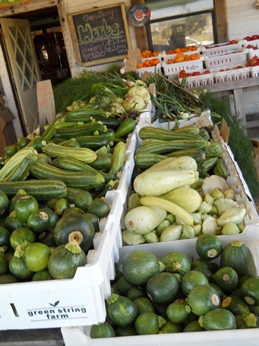Green Tomato: What Do You Really Know About Your Food?
01 October 2011
 As educators of future culinarians, we have a unique opportunity to help mold the future of the American diet.
As educators of future culinarians, we have a unique opportunity to help mold the future of the American diet.
By Dana Cox
Particularly since we entered the current recession, there’s been a renewed hue and cry to buy goods that are “made in the USA.” While I wholeheartedly agree with that principle, I find it puzzling that many of those same people think nothing about eating fruit or vegetables that have traveled thousands of miles from far-flung countries before arriving at the local supermarket. The most recent figures from the United States Department of Agriculture show that imports of fresh fruit and vegetables between 1990 and 2006 surged from $2.7 billion to $7.9 billion.
With those imports has come year-round availability of everything from strawberries to rutabagas. That may sound great on the surface, but there are profound environmental and economic consequences. It has also caused us to lose touch with our food, how and where it’s produced, and the whole concept of seasonality. This dawning realization has given rise to the locavore movement that seeks to bring us closer to the food we eat by forging connections with those who produce it. Recognizing that the foods we eat have a tremendous political, environmental, social and health impact, locavores aim to source as much food as possible from a 100-150 mile radius.
Sourcing food locally has a number of important benefits that go far beyond the financial support it provides to local producers and the community. Here are just a few:
Quality. Because the product doesn’t have far to travel, fruit and vegetables can be harvested at their peak of ripeness. Anyone who has tasted a tomato fresh from the vine or an apple just plucked from its tree knows that the smell, taste and texture are completely different from one shipped great distances. Product that is destined hundreds or thousands of miles away must be harvested long before its peak so that it is still saleable when it reaches its final destination.
Variety. When purchasing from broadline distributors or grocery stores, there is rarely a choice of more than one or two varieties of a particular fruit or vegetable. Over the years, corporate agriculture has winnowed production down to the few varieties that travel well. Small, local producers, on the other hand, can grow small amounts of many varieties, including heirloom produce that had largely gone by the wayside and is now being rediscovered. This may be best illustrated by at a recent visit to the Green String Institute farm in Petaluma, Calif., where four to six varieties of both heirloom tomatoes and heirloom summer squash were available for sale.
Nutrition. A number of factors impact the nutrition of our fruits and vegetables, including transportation time and handling. Because produce sourced from local, small farms isn’t generally subjected to harvest by machinery and passed through a number of hands before reaching its final destination, which may be hundreds or thousands of miles away, it will, understandably, have more of its nutrients intact.
Connection. Purchasing locally, either through a Community Supported Agriculture (CSA) program or at farmers’ markets, forges a connection between you, your food and its source. Oftentimes, you can talk to the grower personally and learn how he cultivates his product, whether or not it is organic, biodynamic or produced in a conventional manner, when it was harvested, and what you might expect to see coming to market in the coming weeks.
Respect. That connection and knowledge helps forge a respect and reverence for food, something that has largely been lost in this day of anonymous, processed food. Unlike corporate agriculture that usually doesn’t own its land, small local producers have often held their land within their families for generations so they are committed to preserving it and their artisanal farming traditions for future generations. Understanding that brings a new respect for what goes into producing our food.
In thinking about how to bring that knowledge to students, here are a few classroom activities that are designed to illustrate the benefits of being a locavore:
- Go completely local for a day. Develop a lesson plan that challenges students to create a menu that uses only products that can be found locally. Start with a trip to the local farmers’ market, where each student must choose some ingredients and share with the class how they were produced and where. In the case of prepared products such as olive oil, have them explain where the olives were grown, as well as how and where they were processed.
- Taste, taste, taste. Nothing like a blind tasting will drive home the quality difference. Have students taste and compare fresh fruit and vegetables grown locally and those available from your broadline distributor. What are the differences in smell, taste, texture and appearance?
- Challenge students to eat locally for a week. As extra credit, think about challenging your students to “go locavore” for a week and track their experience. That means they must be able to trace the origin of each food item to within 150 miles of the campus. When the week is done, discuss the experience. It will be a rich learning opportunity for both you and your students.
Chefs set the trends for the way we eat. As educators of future culinarians, we have a unique opportunity to help mold the future of the American diet. There’s no doubt that sourcing locally takes commitment, additional effort, ongoing communication with individual producers and, often, a willingness to pay a bit more. However, I strongly believe that the benefits will far outweigh the investment in terms of food quality, health, support of the local economy and building a sustainable value system.
Dana Cox is a chef instructor at the Kendall College School of Culinary Arts in Chicago who recently received Women Chefs & Restaurateurs’ Catherine Brandel Scholarship for her “Honest Meal Project,” a year-long experiment during which Cox consumed only foods grown on family farms.
Photo caption: Green String heirloom summer squash with varieties such as Romanesco, Green Scallop, Ronde de Nice and Lungo Bianco.
Additional Info
- CAFÉ Talks Podcast Lesson Plan: 1



